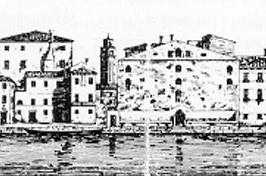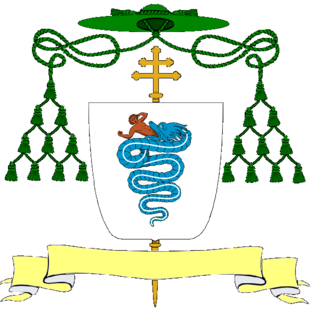
Galeazzo Maria Sforza was the fifth Duke of Milan from 1466 until his death. He was famous for being lustful, cruel and tyrannical.
Associazione Calcio Dilettantistica Legnano, commonly referred to as Legnano, is an Italian football club based in Legnano, Lombardy. Founded in 1913, Legnano played three seasons in Serie A and a total of eleven seasons in the top tier of the Italian football league system.

Salvadore Cammarano was a prolific Italian librettist and playwright perhaps best known for writing the text of Lucia di Lammermoor (1835) for Gaetano Donizetti.
Carlo Visconti was an Italian, who was a member of the prominent Visconti family, and a government secretary in Milan's Council of Justice, he was executed for being the assassin of Galeazzo Maria Sforza, the Duke of Milan.
Gerolamo Olgiati was a government official in Milan and one of the assassins of Galeazzo Maria Sforza, the Duke of Milan, along with Giovanni Andrea Lampugnani and Carlo Visconti.
Franzone was a servant of the Lampugnani family of Milan, and a figure in the assassination of Galeazzo Maria Sforza, the Duke of Milan.

Rescaldina is a comune (municipality) in the Province of Milan in the Italian region Lombardy, located about 25 kilometres (16 mi) northwest of Milan.

John of Legnano was an Italian jurist, a canon lawyer at the University of Bologna and the most prominent defender of Urban VI at the outbreak of the Western Schism.
Stadio Giovanni Mari is a multi-use stadium in Legnano, Italy. It is currently used mostly for football matches and is the home ground of A.C. Legnano. The stadium holds 5,000 people. It is also used for the horse race of Palio di Legnano.
Giovanni Raboni was an Italian poet, translator and literary critic.

The 1927 Giro d'Italia was the 15th edition of the Giro d'Italia, a cycling race organized and sponsored by the newspaper La Gazzetta dello Sport. The race began on 15 May in Milan with a stage that stretched 288 km (179 mi) to Turin, finishing back in Milan on 6 June after a 291.5 km (181 mi) stage and a total distance covered of 3,758.3 km (2,335 mi). The race was won by the Alfredo Binda of the Legnano team. Second and third respectively were the Italian riders Giovanni Brunero and Antonio Negrini.

The 1925 Giro d'Italia was the 13th edition of the Giro d'Italia, a cycling race organized and sponsored by the newspaper La Gazzetta dello Sport. The race began on 16 May in Milan with a stage that stretched 278.1 km (173 mi) to Turin, finishing back in Milan on 7 June after a 307.9 km (191 mi) stage and a total distance covered of 3,520.5 km (2,188 mi). The race was won by the Alfredo Binda of the Legnano team. Second and third respectively were the Italian riders Costante Girardengo and Giovanni Brunero.

The 1922 Giro d'Italia was the 10th edition of the Giro d'Italia, a cycling race organized and sponsored by the newspaper La Gazzetta dello Sport. The race began on 24 May in Milan with a stage that stretched 326 km (203 mi) to Padua, finishing back in Milan on 11 June after a 348 km (216 mi) stage and a total distance covered of 3,095 km (1,923 mi). The race was won by the Italian rider Giovanni Brunero of the Legnano team. Second and third respectively were the Italian riders Bartolomeo Aymo and Giuseppe Enrici.

The 1921 Giro d'Italia was the 9th edition of the Giro d'Italia, a cycling race organized and sponsored by the newspaper La Gazzetta dello Sport. The race began on 25 May in Milan with a stage that stretched 333 km (207 mi) to Merano, finishing back in Milan on 12 June after a 305 km (190 mi) stage and a total distance covered of 3,107 km (1,931 mi). The race was won by the Italian rider Giovanni Brunero of the Legnano team. Second and third respectively were the Italian riders Gaetano Belloni and Bartolomeo Aymo.

The Teatro San Angelo or Teatro Sant' Angelo was once a theatre in Venice which ran from 1677 until 1803.

Roberto Visconti was an Italian Roman Catholic archbishop.

The Basilica of San Magno is a Renaissance style Roman Catholic Basilica church in Legnano, in the Province of Milan, Italy. It is the main church in Legnano.











